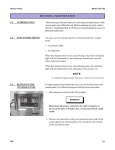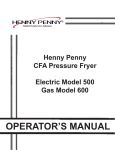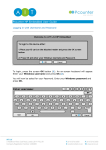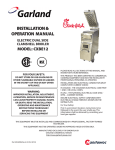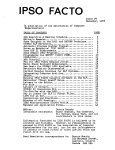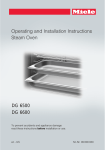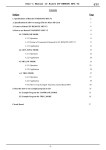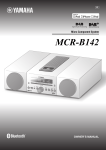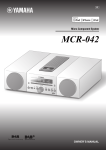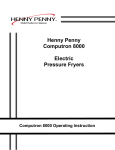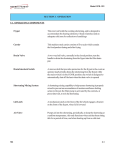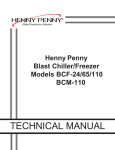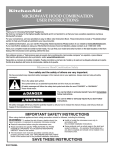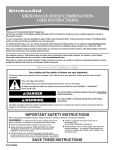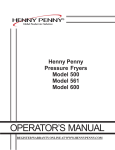Download Henny Penny Chick-fil
Transcript
Henny Penny Chick-fil-A Controls Henny Penny Chick-fil-A Controls Chick-fil-A Controls TABLE OF CONTENTS Section Section 1. Section 2. Section 3. Page INTRODUCTION ........................................................................................... 1-1 1-1 Introduction ........................................................................................... 1-1 1-2 Assistance ............................................................................................. 1-1 1-3 Safety ................................................................................................... 1-2 ............................................................................................................. OPERATION ................................................................................................... 2-1 2-1 Operating Controls ................................................................................ 2-1 2-2 Clock Set .............................................................................................. 2-3 2-3 Diagnostic Mode and Special Functions ................................................. 2-5 2-4 Warnings and Error Messages ............................................................... 2-8 2-5 Basic Operations ................................................................................... 2-11 2-6 Clean-Out Mode ................................................................................... 2-16 2-7 Manually Setting New or Used Peanut Oil ............................................. 2-17 2-8 Checking Temperature Probe Calibration ............................................... 2-17 TROUBLESHOOTING ................................................................................... 3-1 3-1 Introduction ........................................................................................... 3-1 3-2 Troubleshooting ..................................................................................... 3-1 3-3 Diagnostic Mode Details ........................................................................ 3-10 3-4 Information Mode Details ...................................................................... 3-26 Warranty FM01-908-A 602 i Henny Penny Chick-fil-A Controls SECTION 1. INTRODUCTION 1-1. INTRODUCTION The Chick-fil-A controls for the Henny Penny models 500 (electric) and 600 (gas) have many features to allow the Operator to produce consistent, quality products. The controls monitor not only cooking times and temperatures, but also peanut oil condition, product weights, product temperatures, and many other operational variables. The controls may vary the actual peanut oil temperature and cook times, based on changes of the operational variables. The controls also have very extensive self-diagnostic functions which alert the Operator to both component and procedure problems. Some unique features of the fryer are listed below: • Diagnostic Function-provides summary of fryer and Operator performance. See section 2-4. • Alarms and Error Messages-provide immediate feedback for Operator error or fryer malfunction. See section 2-5. • Status Mode-allows the Operator to view basic fryer information and status. See section 2-4. • Information Mode-gathers and stores historic information on the fryer and Operator performance, and can be viewed by the Operator. See section 2-4. • Oil Filter Enforcement-prevents the Operator from exceeding approved number of cook cycles before filtering the peanut oil. See section 2-4. • Manual Program Mode-Operator can set time and temperature for nonstandard products. See section 2-4. • Easy toggle between English and Spanish operation. See section 2-4. • Clean-Out Mode-a preprogrammed function for cleaning the frypot. See section 2-14. 1-2. ASSISTANCE 1-1 Should you require outside assistance, just call Henny Penny Corporation at 1-800-417-8405, or 937-456-8405. 602 Henny Penny Chick-fil-A Controls SECTION 2. OPERATION 2-1. OPERATING CONTROLS Figure Item No. No. Description Figure 2-2 shows the location of following computer control items. Function 2-2 1 Lights when the control calls for heat and the peanut oil should start heating. 2-2 2 2-2 3 Lights when the solenoid closes and pressure starts to build inside frypot. 2-2 4 Flashes when the peanut oil temperature is NOT at the proper temperature for dropping product into the frypot. 2-2 5 Lights when the peanut oil temperature is 5°F below setpoint to 15°F above the cooking temperature, signaling product can now be be cooked. 2-2 6 Press to display current fryer information and status. If pressed in the Program Mode, shows previous settings. Pressing this along with accesses the Information Mode which has Digital Display Shows all the functions of the cooking cycle, Program Mode, Diagnostic Mode and alarms. historic information on the Operator and fryer performance. 2-2 7 Used to adjust the value of the currently displayed setting in the Program Modes. 2-2 8 Press to access Program Mode. Once in the Program Mode, it is used to advance to the next setting. If pressed along with it accesses the Information Mode which has historic information on the Operator and fryer performance. It also allows access to the English-Spanish settings, diagnostics, Clean-Out Mode, and Manual Mode, if pressed before the appropriate button. 2-2 602 9 Used to start and stop cooking cycles and to stop the timer at the end of a holding cycle. It is also used to program a Manual Program for nonstandard products. 2-1 Henny Penny Chick-fil-A Controls 2-1. OPERATING CONTROLS (Continued) 2-2 10 Menu Card 2-2 11 Product Select Shows name of food product selected. The menu card strip is located behind the decal. Press to select food products to be cooked, as well as, answering display prompts. Also, accesses the diagnostics; , the Clean-Out Mode; and toggles between English and Spanish display. (Press before entering any of the above modes.) 2-2 12 Cook/Pump Switch 2-2 13 Unit Identification Window 13 12 2 10 1 3 A 3-way switch with a center OFF position. Turn the switch to COOK to operate the fryer. Turn the switch to PUMP to operate the filter pump. Certain conditions must be met before operating the filter pump. These conditions are covered later in this section. The unit’s model number and the control’s hardware and software version numbers appear here. 4 5 6 11 7 8 9 Control Decal Figure 2-2 2-2 602 Henny Penny Chick-fil-A Controls 2-2. CLOCK SET Upon initial start-up or PC board replacement, if “CLOCK SET” automatically appears in the display, skip steps 1, 2 and 3. 1. Press and hold display. 2. Release for 5 seconds until “LEVEL 2” shows in , then press twice. “CLOCK SET” then “ENTER CODE” shows in display. 3. Press . . 4. Display shows “CS-1” then “SET” then “MONTH”, with the month flashing. 5. Press 6. Press to change the month. . Display shows “CS-2 then SET then DATE” with the date flashing. 7. Press 8. Press to change the date. . Display shows “CS-3 then SET then YEAR” along with the year flashing. 9. Press 10. Press to change the year. . Display shows “CS-4 then SET then HOUR” shows with the hour and “AM” or “PM” flashing. 11. Press to change the hour and AM/PM setting. 12. Press . Display shows “CS-5, SET, MINUTE” with the minutes flashing. 13. Press 602 to change the minutes. 2-3 Henny Penny 2-2. CLOCK SET (Continued) Chick-fil-A Controls 14. Press . Display shows “CS-6” then “CLOCK MODE” along with “1.AM/PM”. 15. “1.AM/PM” is 12 hour time, “2.24-HR” is 24 hour time. Press to change. 16. Press . Display shows “CS-7” then “DAYLIGHT SAVINGS ADJ” along with “2.US”. 17. Press to change to the following: a. “1.OFF” = No automatic adjustments for Daylight Savings Time. b. “2.US” = Automatically applies United States Daylight Savings Time adjustment. DST activated on the first Sunday in April. DST de-activated on the last Sunday in October. c. “3.EURO” = Automatically applies European (CE) Daylight Saving Time adjustment. DST activated on the last Sunday in March. DST de-activated on the last Sunday in October. 18. Clock Set is now complete. Press and hold 2-4 to exit. 602 Henny Penny 2-3. DIAGNOSTIC MODE AND SPECIAL FUNCTIONS Chick-fil-A Controls Diagnostic Mode To view summaries of the fryer and Operator performance, press then . Press to view the following functions: D1 - Adjust product color for all products (not individually) D2 - The age of the peanut oil and life remaining D3 - Outlet voltage monitoring D4 - Fryer’s heating performance D5 - Slow or oversized product batches D6 - Cook cycles started before temperature recovered D7 - Cook cycles stopped more than 10 seconds before end of cycle D8 - Cook cycles not ended within 20 seconds after expired time D9 - Number of times loading product took too long D10 - Programmed variables changed by Operator On several of the screens you may have to press respond to questions asked. Press or to at any time to exit and return to normal operation. See section 5-3 for more details of the Diagnostic Mode. Peanut Oil Life Function Based on the number of cook cycles of specific products and the amount of time the fryer idles, the controls tell the Operator when to change the peanut oil. “CHANGE OIL SOON” shows on the display when the controls determine it’s time to change peanut oil. Unless the peanut oil is smoking or has a burnt flavor, the peanut oil does not need to be changed before this message shows on the display. After cleaning the frypot, using the Clean-Out Mode (section 3-14), this function resets. Language Selection Pressing then allows the Operator to choose to have the information on the display in English or Spanish. 602 2-5 Henny Penny 2-3. DIAGNOSTIC MODE AND SPECIAL FUNCTIONS (Continued) Chick-fil-A Controls Manual Mode This allows the Operator to quickly program a time and temperature for nonstandard products that are not on the menu card. This is to be a temporary setting and disables most of the advanced features of the controls. To enter Manual Mode: 1. Once out of the Melt cycle, press 2. Use 3. Press 4. Press . to set cook time. and use to set temperature. to start Manual Mode. Display shows “MANUAL” and you start a cook cycle by pressing 5. Press then . to exit Manual Mode. Status Mode Pressing during idle time, allows Operator to view: a. b. c. d. e. The temperature of the peanut oil The temperature setpoint and any offset The average peanut oil temperature during last cook cycle The rate of temperature rise or fall Date and Time Pressing during a cook cycle allows the Operator to view: a. The temperature of peanut oil, plus the degrees and rate the Load Compensation has affected the cook cycle (slows down or speeds up the timer) b. The cooking step, the time left in cook cycle, setpoint temperature and whether pressure is on c. The average peanut oil temperature in cook cycle so far d. The rate of temperature rise or fall e. Date and Time After 5 seconds, the control exits the Status Mode and the pressure fryer returns to normal operation. Peanut oil Filter Enforcement Prevents the Operator from exceeding the set number of cook cycles before filtering the peanut oil. The number in the center of the display shows how many cook cycles remain before the Filter Lockout occurs. For example, “5X” means the Operator can run 5 more cook cycles before filtering. This function cannot be bypassed and greatly increases the life of the peanut oil. 2-6 602 Henny Penny 2-3. DIAGNOSTIC MODE AND SPECIAL FUNCTIONS (Continued) Chick-fil-A Controls Information Mode This mode gathers and stores historic information on the fryer and Operator performance. Press and at the same time and “*INFO MODE*” shows on display. Press steps and press or to access the to view the statistics within each step. Information Mode is intended for technical use, but the Operator can view the following information: 1. E-LOG - last 10 errors and time they occurred 2. P-LOG - time of last 10 power-ups 3. HEAT-UPS - time of day and maximum heating rate (°/second) for the last 10 heat-ups 4. COOK DATA - information on the last cook cycle 5. TODAY’S DATA - data since the start of day (not including the last cook cycle) 6. PREV-DAY-SUN - creates a log of the last 7 days, using the information in TODAY’S DATA. 7. 7-DAY TOTALS -totals the information from the last 7 days 8. OIL DATA - information on the current peanut oil, not including today’s cooking information 9. PREV OIL DATA - information on last batch of peanut oil 10. INP - provides test of fryer inputs 11. OUTP - shows the state of heater and pressure 12. POT TMP - temperature of peanut oil 13. CPU TMP - temperature of PC board 14. ANALOG - status of controller’s a-to-d converter 15. AC VOLTS - status of the line voltage to fryer 16. AMPS (Electric models only) - the present amp readings to heaters. See section 5-4 for more details of the Information Mode. 602 2-7 Henny Penny Chick-fil-A Controls 2-4. WARNINGS AND ERROR MESSAGES The controls monitor procedure problems and system failures with warnings and error codes. The display shows the warning or error code, and an alarm sounds. Pressing cancels most warnings, and pressing any control button stops most Error Code alarms. But there are some exceptions (see below). The display shows the error until the situation is corrected. WARNINGS DISPLAY CAUSE CORRECTION “W-1” “LOW VOLTAGE” Incoming supply voltage too low. Have voltage at plug and receptacle checked. “W-2” “SLOW HEAT-UP” Faulty components or connections. Have elements, connections, and contactors checked. “W-3” “WAS NOT READY” Product loaded into frypot before lights. Wait until peanut oil is at proper temperature before loading product. “W-4” “SLOW COOKING” Frozen or too much product in frypot. Do not overfill or place frozen product into the frypot. “W-5” “SLOW COOKING” Product loaded into frypot before lights. Wait until peanut oil is at proper temperature before loading product. “W-6” “SLOW COOKING” Faulty components or connections. Have elements, connections, and contactors checked. “W-7” LOW AMPS Faulty components or connections. Have elements, connections, and contactors checked. “W-9” “DISCARD PRODUCT” Product overcooked. (May appear after a Slow Cooking warning.) Discard product immediately. Didn’t allow peanut oil to drop down to current product’s setpoint temperature. Cancel button will not stop this warning. Once the peanut oil temperature drops to setpoint temperature, the alarm automatically stops. “OIL TOO HOT” 2-8 602 Henny Penny Chick-fil-A Controls 2-4. WARNINGS AND ERROR MESSAGES (Continued) ERROR CODES DISPLAY “E-4” “CPU TOO HOT” CAUSE CORRECTION PC board too hot. Check ventilation louvers on side of fryer for obstructions. If louvers are clear, have PC board checked. Check cooling fan if present. “E-5” “FRYER TOO HOT” Controls sensing 405°F or above. Have heat components and temperature probe checked. “E-6” (A or B) “FRYER TEMP SENSOR FAILED” Faulty temperature probe or connection. Have temperature probe and connection checked. “E-10” “HIGH LIMIT TRIPPED” Peanut oil temperature too hot, drain valve opened while heat was on, or faulty high limit. Reset high limit. Check peanut oil temperature for overheating. Have heat components checked if high limit continues to trip. “E-15” “DRAIN IS OPEN” Drain is open or faulty microswitch. Close drain. Have drain microswitch checked if error code persists. Wrong or faulty elements or wiring problem. Have electrical supply, wiring, and elements checked. (500 fryer only) “E-25” “HEAT AMPS WERE TOO HIGH Because of the seriousness of this error code, turn the Cook/Pump switch OFF and back to COOK to cancel. 602 2-9 Henny Penny Chick-fil-A Controls 2-4. WARNINGS AND ERROR MESSAGES (Continued) ERROR CODES DISPLAY (500 fryer only) “E-26” “HEAT AMPS ARE LOCKED ON” CAUSE CORRECTION Faulty contactors or PC board. Have the contactors and PC board checked. This error code could be displayed even with the Cook/Pump switch turned OFF. Unplug fryer or shut off the wall circuit breaker to disconnect electrical power to fryer. “E-41” “SYSTEM DATA LOST” Memory scrambled. An individual product program may be scrambled. Ex: “E-41 -2- DATA LOST”. This means product #2 program is scrambled. Turn the Cook/Pump switch OFF and back to COOK. If error code persists, have the PC board checked or re-initialized. “E-46” “DATA SAVE FAILED” Faulty eprom or PC board. Turn the Cook/Pump switch OFF and back to COOK. If error code persists, have the PC board checked or re-initialized. “E-70” “PWR SW OR WIRES FAILED” Faulty Cook/Pump switch or switch wiring. Faulty I/O board. Have Cook/Pump switch checked, along with its wiring. Have I/O board checked. “E-92” “24 VOLT FUSE” Blown 24 volt controller fuse, or bad 14-pin cable connection. Have the 14-pin cable connector checked or have the fryer checked for a short to ground in components such as the drain switch, solenoid, or high limit. Have solenoid checked and cleaned. Stuck or clogged solenoid valve. 2-10 602 Henny Penny 2-5. BASIC OPERATION Chick-fil-A Controls The following procedures should be followed on the initial start-up of the fryer, and each time the fryer is brought back into operation from a cold or shut down condition. These are basic, general instructions. 1. Check to see that the Cook/Pump switch is turned OFF. 2. Make sure the drain valve and filter valve are closed. 3. Remove the fry basket from the frypot and leave lid up. 4. Make sure the peanut oil is filled to the proper level in the frypot; 1/4 to1/2 inch (6.4-12.7 mm) below level indicator line. 5. Connect power to the fryer. 6. On gas models, light the pilot light. 7. Turn the Cook/Pump switch to COOK. Upon initial start-up “CLOCK SET” shows in display. Set the clock to your time, following prompts on the display, or see section 3-3 for help. Then display asks if the peanut oil is NEW or OLD. The controls automatically adjust the peanut oil temperature to the age of the peanut oil. Use to set the number of days of old peanut oil. 8. Unit automatically goes into the melt cycle, until the peanut oil temperature reaches 230°F (110°C). Then the controls go into the heat cycle and heats the peanut oil to preset temperature. Once melted peanut oil reaches the proper level in the frypot, the melt cycle can be bypassed by pressing and holding one of the Product buttons. Do not bypass the melt cycle unless enough melted peanut oil completely covers the elements in electric fryers or the curved frypot surface in gas fryers. Excessive smoking or fire could result. 9. Stir the peanut oil as it is heating up from a “cold” start. Be sure to stir down into the bottom of the frypot. 602 2-11 Henny Penny 2-5. BASIC OPERATION (Continued) Chick-fil-A Controls 10. Once out of the melt cycle, flashes until 5° before setpoint temperature ( plus any offset temperature). Then and the selected product shows on the display. lights The heat cycles on and off about 4 degrees before the setpoint temperature to help prevent overshooting the setpoint temperature (proportional control). 11. If the peanut oil was not filtered the night before at shutdown, filter the peanut oil now. Refer to section 3-9. 12. Follow the steps in Chick-fil-A’s training materials to load the product. Before loading product, make certain is lit, indicating that the peanut oil is at the correct cooking temperature for the type of product being cooked. The actual temperature may vary 20 degrees or more depending peanut oil age, product weights, product temperature, and other operational variables. Do not overload, or place product with extreme moisture content into the basket. 12-14 lb (5.44-6.35 kgs.) is the maximum amount of product. Failure to follow these instructions can result in peanut oil overflowing the frypot, causing burns or damage to the fryer. 13. Close the lid quickly, latching the lid. Do not press until lid is closed, or the lid will try to lock as it is being tightened down. 14. Tighten the lid spindle clockwise, sealing the lid. Align the red knob on the spindle with the red knob on the latch. 2-12 602 Henny Penny Chick-fil-A Controls 2-5. BASIC OPERATION (Continued) PRESSURIZED LATCH THE LID PROPERLY AND ALIGN THE RED BALLS OR SEVERE BURNS WILL RESULT. 15. Press the desired Product button to start a cook cycle. The display counts down the cooking time. To check the peanut oil temperature press cook cycle, press . . To stop a The cook times may vary, compensating for peanut oil age, product weights, product temperature, and other operational variables. 16. Within a few minutes, the pressure gauge should increase to the OPERATING ZONE. If not, recheck the Installation and Operation procedures. 17. Near the end of the cook cycle, the fryer automatically depressurizes. Then at the end of the cook cycle, an alarm sounds, and the display flashes “DONE”. Press to stop the alarm. DEPRESSURIZE CHECK THE PRESSURE GAUGE READING. DO NOT ATTEMPT TO OPEN THE LID UNTIL THE PRESSURE DROPS TO ZERO. OPENING THE LID WHEN THE FRYPOT IS PRESSURIZED ALLOWS HOT PEANUT OIL AND MOISTURE TO ESCAPE FROM THE FRYPOT, RESULTING IN SEVERE BURNS. 18. After pressure drops to zero, turn the spindle counterclockwise. Do not flip or spin the spindle cross arm when opening because it could damage the acme nut inside the cross bar. 602 2-13 Henny Penny 2-5. BASIC OPERATION (Continued) Chick-fil-A Controls 19. Unlatch and raise the lid quickly to allow most of the condensation on the lid to drain through the drain channel and not into the peanut oil. Do not let lid slam up against its backstop because this could damage the hinge. 20. Follow the steps in Chick-fil-A’s training materials to unload the product and check for doneness. After the cook cycle, if the product needs to cook more, place basket back into frypot and press for an additional 45 seconds. 21. Before frying next load, allow for the peanut oil to reheat and lights. In the Cook mode, when “FILTER SUGGESTED”, shows in the display, the operator has the option to filter at this time, or to continue cooking. But, if the operator continues cooking, a Filter Lockout occurs within the next cook cycle, or two. When “FILTER LOCKOUT” , then “YOU *MUST* FILTER NOW........” shows in the display, is the only button that functions, until the peanut oil is filtered. Follow Chick-fil-A’s training materials on filtering. Discard peanut oil if display shows “CHANGE OIL SOON” or if peanut oil shows signs of excessive foaming or smoking. With prolonged use, the flashpoint of peanut oil is reduced. Discard peanut oil if it shows signs of excessive smoking or foaming, or serious burns, personal injury, fire and/or property damage could result. 2-14 602 Henny Penny 2-6. CLEAN-OUT MODE Chick-fil-A Controls The Chick-fil-A control has a Clean-Out Mode to clean the frypot upon initial start-up and every change of shortening. Follow the steps in Chick-fil-A’s training materials on Cleaning the Frypot. When heating the cleaning solution, turn the Cook/Pump switch to COOK. Press then . “CLEAN-OUT ?” then “1=YES 3=NO” shows in display. Press to start Clean-Out Mode. The fryer displays “*CLEAN-OUT MODE*” and heats up to a preprogrammed temperature, then automatically begins a 15-minute timed countdown. Use , if necessary to adjust the temperature and keep the cleaning solution from boiling over. NEVER PRESSURIZE FRYER TO CLEAN. LEAVE THE LID OPEN. WATER UNDER PRESSURE IS SUPER HEATED AND CAUSES SEVERE BURNS IF IT COMES IN CONTACT WITH SKIN. DO NOT let the cleaning solution boil. If the cleaning solution in the frypot starts to foam and boil over, IMMEDIATLY TURN THE COOK/PUMP SWITCH TO OFF. DO NOT try to contain it by closing the lid or severe burns could result. 602 2-15 Henny Penny 2-7. MANUALLY SETTING NEW OR USED PEANUT OIL FUNCTION Chick-fil-A Controls 1. Turn the Cook/Pump switch to off. 2. Press and hold while turning the Cook/Pump switch to COOK, until “IS OIL NEW OR USED?” shows in the display. 3. Press 4. If Press for new peanut oil, or for used peanut oil. was pressed, “OIL IS NEW?” shows in the display. for YES, and “THANK YOU” shows in the display, and controls resume normal operation. 5. If 6. Press 7. Press 8. Press was pressed, “OIL IS USED?” shows in the display. for YES, and “HOW OLD IS OIL?” shows in display. to set the age of the peanut oil. . “THANK YOU” shows in the display and controls resume normal operation. 2-8. CHECKING TEMPERATURE PROBE CALIBRATION 1. Heat peanut oil and stir completely until peanut oil temperature has stabilized and is on. 2. Place and electronic thermometer about 3 inches below the peanut oil’s surface, in the center of the frypot. Let the temperature stabilize and remember the reading. 3. Press to see the probe’s temperature reading. If the displayed temperature is less than 5 degrees from the electronic thermometer’s temperature, see D 1, Color Adjustment on page 5-11. If temperature differs from 5 to 15 degrees, or still can’t get the correct color, have the probe calibrated. If temperature differs by more than 15 degrees, have probe replaced. 2-16 602 Henny Penny Chick-fil-A Controls SECTION 3. TROUBLESHOOTING 3-1. INTRODUCTION This section provides troubleshooting information in the form of an easy to read table. If a problem occurs during the first operation of a new fryer, recheck the installation and operation sections of this manual. 3-2. TROUBLESHOOTING To isolate a malfunction, proceed as follows: 1. Clearly define the problem (or symptom) and when it occurs. 2. Locate the problem in the Troubleshooting table. 3. Review all possible causes. Then, one-at-a-time work through the list of corrections until the problem is solved. 4. Use the Diagnostic Mode to identify the problem and make possible adjustments. If a problem keeps reoccurring, have a qualified service technician check the fryer for other causes. 602 3-1 Henny Penny Problem Chick-fil-A Controls Cause Correction COOKING SECTION Product Color Not Correct: A. Too Dark (some batches) B. Too Dark (all batches) • Temperature programmed too hot • See Diagnostic Mode D 10, page 5-24. If temperature settings have been changed, have the controls reintialized. • Breading product too far • Bread product just before frying. • Done alarm ignored for more than 20 seconds • If the fryer hasn’t been used since the problem batch, see Information Mode 4 H, page 5-27. For more information on this problem, see Information Modes 5 U, 6 U, 7 R, or 8 R, pages 5-28 to 5-31. • Wrong Product button pressed • Be sure to press the correct product button. If the fryer hasn’t been used since the problem batch, see Information Mode 4 B, page 5-27 to see what product button was pressed. • Temperature probe out of • Check temperature probe calibration. • Peanut oil too old. calibration. See section 4-6. a.If less than 5° off, see Diagnostic Mode D 1, page 5-11. b.If between 5 and 15 degrees off, calibrate probe. If more than 15 degrees off, replace probe. • If peanut oil is smoking or has burnt taste, change peanut oil. • See Diagnostic Mode D 2, page 5-12. Change peanut oil if controls indicate it should be changed. • Peanut oil too dark. • Filter peanut oil. • Change peanut oil. • Faulty probe. “E6” • If probe can’t be recalibrated, have probe replaced. 3-2 602 Henny Penny Problem C. Too Light (all batches) Chick-fil-A Controls Cause Correction COOKING SECTION (Continued) • Slow fryer heat-up/recovery. • See Diagnostic Mode D 4, page 5-15 for present day’s performance. Or see Information Modes 5, 6, 7, 8, and 9 for more information on this problem, pages 5-28 to 5-32. • Low voltage. See Diagnostic Mode D 3, page 5-13 for present day’s voltage performance. See Information Modes 4, 5, 6, 7, 8, 9, and 14 for more information on this problem, pages 5-27 to 5-32. • Low gas pressure. Have gas pressure checked going to burners, on gas fryers. • Temperature probe out of calibration. D. Too Light (some batches) • Check temperature probe calibration. See section 4-6. a.If less than 5° off, see Diagnostic Mode D 1, page 5-11. b.If between 5 and 15 degrees off, calibrate probe. If more than 15 degrees off, replace probe. • Oil usage wasn’t set for new peanut oil. • See Diagnostic Mode D 2 for the age of the oil. See section 3-7 for setting the age of the oil. •Temperature programmed too low • See Diagnostic Mode D 10, page 5-24. If temperature settings have been changed, without authorization, have the controls reintialized. • Product placed in peanut oil • If fryer hasn’t been used since before proper temperature • Wrong cook button pushed. the problem batch, see Information Mode 4 C, page 5-27. For more information on this see Information Modes 5 S, 6 S, 7 P, or 8 P, pages 5-28 to 5-31. • If fryer hasn’t been used since problem batch, see Information Mode 4 B, page 5-27 to see what product was selected. 602 3-3 Henny Penny Chick-fil-A Controls Problem Cause Correction COOKING SECTION (Continued) B. Too Light (Continued) • Cook cycle aborted before alarm and “DONE” flashes. • See Diagnostic Mode D 7, page 3-20, to see how many times the cook cycle was stopped before the end of the cycle. • Frozen product placed in • Use fresh or thawed product. peanut oil Dryness of Product • Moisture loss prior to cooking See Diagnostic Mode D 5, page 3-17, to see if the controls sensed any frozen or overloaded batches. • Use fresh product. • Cover product with plastic wrap, reducing evaporation. • Over-cooking the product. • Done alarm ignored for more than 20 seconds. If the fryer hasn’t been used since the problem batch, see Information Mode 4 H, page 3-27. For more information on this problem, see Information Modes 5 U, 6 U, 7R, or 8 R, pages 3-28 to 3-31. • Time of cook eycle set too long • See Diagnostic Mode D 10, page 3-24. If time settings have been changed, have the controls reintialized. • Wrong cook button pushed. • If fryer hasn’t been used since problem batch, see Information Mode 4 B, page 3-27 to see what product was selected. Burned Taste 3-4 • Low operating pressure • Check pressure gauge reading. Check for pressure leaks. • Burned Peanut oil flavor • Replace Peanut oil • Peanut oil needs filtering • Filter peanut oil more often. • Frypot not properly cleaned. • Drain and clean frypot. 602 Henny Penny Problem Chick-fil-A Controls Cause Correction COOKING SECTION (Continued) Product not done • Cook cycle aborted before alarm, and “DONE” flashes. • See Diagnostic Mode D 7, page 5-20, to see how many times the cook cycle was stopped before the end of the cycle. • Frozen product placed in peanut oil • Use fresh or thawed product. See Diagnostic Mode D 5, page 5-17, and if the controls sensed frozen or overloaded batches. • Wrong cook button pushed. • If fryer hasn’t been used since problem batch, see Information Mode 4 B, page 5-27 to see what product was selected. • Temperature programmed too low or not prorammed properly. • See Diagnostic Mode D 10, page 5-24. If temperature settings have been changed, have the controls reintialized. • Temperature probe out of calibration. • Check temperature probe calibration. See section 4-6. a.If less than 5° off, see Diagnostic Mode D 1, page 5-11. b.If between 5 and 15 degrees off, calibrate probe. If more than 15 degrees off, replace probe. • Slow fryer heat-up/recovery. • See Diagnostic Mode D 4, page 5-15 for present day’s performance. Or see Information Modes 5, 6, 7, 8, and 9 for more information on this problem, pages 5-28 to 5-32. • Low voltage. See Diagnostic Mode D 3, page 5-13 for present day’s voltage performance. See Information Modes 4, 5, 6, 7, 8, 9, and 14 for more information on this problem, pages 5-27 to 5-32, and 5-35. • Low gas pressure. Have gas pressure checked going to burners, on gas fryers. • Product too thick. 602 • Make sure chicken filets have been fileted. 3-5 Henny Penny Chick-fil-A Controls Problem Cause Correction POWER SECTION With Cook/Pump Switch in Cook position, fryer is completely without power • Open Circuit. • Check to see if fryer is plugged in. • Check wall circuit breaker or fuse. • Have a qualified service technician check power supply and Cook/Pump switch. PRESSURE SECTION Pressure will not exhaust at end of cooking cycle. • Exhaust line from solenoid valve to exhaust tank clogged. • Solenoid valve clogged. • Turn unit off and allow fryer to cool to release pressure from frypot; have all pressure lines, exhaust stacks, and exhaust tank cleaned. • Have solenoid checked and cleaned. Operating pressure too high • Dead weight clogged. • Turn unit off and allow fryer to cool to release pressure from frypot; remove dead weight and clean, per section 3-16. PRESSURIZED DO NOT OPERATE UNIT IF HIGH PRESSURE CONDITIONS EXIST, SEVERE INJURIES AND BURNS WILL RESULT. PLACE THE COOK/PUMP SWITCH IN THE “OFF” POSITION IMMEDIATELY. RELEASE THE PRESSURE BY ALLOWING UNIT TO COOL. THE PRESSURE WILL THEN DROP. DO NOT RESUME USE OF UNIT UNTIL CAUSE OF HIGH PRESSURE HAS BEEN FOUND AND CORRECTED. 3-6 • Exhaust line to stack clogged. • Clean exhaust line to stack. 602 Henny Penny Chick-fil-A Controls Problem Pressure does not build Cause Correction PRESSURE SECTION (Continued) • Not enough product in fryer • Place proper quantity of or product not fresh. • Metal shipping spacer not removed from dead weight. fresh product within frypot to generate steam. • Remove shipping spacer. See Unpacking Section. • Lid open or not latched. • Close and latch lid. • Solenoid valve leaking or • Have solenoid valve checked or not closing. • Dead weight valve leaking. cleaned. • Have Dead weight valve repaired. • Pressure not programmed. • See Diagnostic Mode D 10, page 3-24. If pressure settings have been changed, have the controls reintialized.. • Lid gasket leaking. • Reverse gasket or lid needs adjusted. • Safety relief valve leaking. • Check and replace if necessary. FILTER SYSTEM SECTION Filter motor runs but pumps peanut oil slowly Filter switch on, motor does not run 602 • Pump clogged • Have pump cleaned. • Filter line connection loose. • Tighten all filter line connections. • Solidified peanut oil in lines • Clear all filter lines of solidified peanut oil. • Defective Cook/ Pump switch • Have switch checked. • Defective motor • Have motor checked. • Motor thermal protector tripped • Reset thermal protector. 3-7 Henny Penny Chick-fil-A Controls Problem Cause Correction FILTER SYSTEM SECTION (Continued) Motor hums but will not pump. • Clogged lines or pump • Have pump and lines removed and cleaned. • Have pump seal, rotor and rollers replaced. HEATING OF PEANUT OIL SECTION Peanut oil will not heat • Blown fuse or tripped circuit breaker • Faulty cord and plug. • Check cord and plug and Check power at receptacle. power at wall receptacle. • Faulty PC Board. • Have control panel checked. • Faulty or tripped high limit. “E10” • Reset high limit per section 3-1. If high doesn’t reset, have it checked. • Drain valve open. “E15” • Close drain valve. • Possible faulty probe. “E6” • Have temperature probe checked. • Possible faulty contactor • See Diagnostic Modes D 4, (electric models) 3-8 • Reset breaker or replace fuse. circuit breaker at supply box. page 5-15. See if “CHECK COILS, CONTACTORS AND WIRING” shows on display. • Gas Valve knob turned to the Off position (gas models) • Make sure the Gas Valve knob is turned to ON. • Faulty Thermocouple (gas models) • Have thermocouple checked. • Faulty Cook/Pump switch. • Faulty drain switch. “E15” • Possible faulty gas control • See Information Mode10, page 5-35 and check to see if the input code is present. If not, have fryer checked by a certified service technician. 602 Henny Penny Problem Chick-fil-A Controls Cause Correction HEATING OF PEANUT OIL SECTION (Continued) Peanut oil heating slowly • Low or improper amps • See Infomation Mode 16, page 5-35, for present amperage. Or see Information Modes 4, 5, 6, 7, 8, 9, for more information on this problem, pages 5-27 to 5-32. Diagnostic Mode D 4 gives present day’s heating performance. • Low or improper voltage • See Diagnostic Modes D 3 & D 4, pages 5-13 & 5-15 for present day’s voltage and heating performance. Or see Information Modes 4, 5, 6, 7, 8, 9, and 15 for more information on this problem, pages 5-27 to 5-32 and 5-35. • Weak or burnt out elements (elec. model) • See Diagnostic Modes D 4, page 5-15. See if “CHECK COILS, CONTACTORS AND WIRING” shows on display. If so, have fryer • Burnt or charred connectors. • Faulty contactor (electric models) 602 checked by a certified service technician. • Wire(s) loose • Have wires tightened • Supply line too small - low gas volume. (gas models) • Increase supply line size. Refer to installation instructions. • Improper ventilation system. (gas models) • Refer to installation instructions. 3-9 Henny Penny 3-3. DIAGNOSTIC MODE DETAILS Chick-fil-A Controls The Chick-fil-A fryer controllers provide Diagnostic functions that let an Operator review operating and performance data for the fryer. The information provided by Diagnostic Mode can be used to monitor procedural errors, such as, not waiting for the Ready light before starting a cook cycle, canceling cycles early, etc. In addition, Diagnostic Mode allows slight adjustment to product color, reports the age and accumulated wear of the oil, and reports information about the performance of the line voltage supply. Accessing Diagnostic Mode To activate Diagnostic Mode, press the button, then press button. The controller displays the following message: “ *DIAGNOSTIC* “ “ *REPORT* “ When this introduction message is finished, the controller displays Diagnostic step D 1 (see below). are used to step through the report items. Press step forward to the next item. Press the report items. to to step backward through The report information is grouped into sections, D 1 through D 10. Most sections have several related items. To toggle between English and Spanish Display Mode, press button then press . To exit Diagnostic Report Mode at any point, press 3-10 . 602 Henny Penny 3-3. DIAGNOSTIC MODE DETAILS (Continued) Chick-fil-A Controls D 1: Color Adjustment This step lets the user make slight adjustments to the product color. The color adjustment is performed by increasing or decreasing the regulating temperature of the fryer. The first step of this item asks “IS PRODUCT COLOR OK?” If product color is okay and no change is desired press to move on to the next item, or press If a change is desired, press or to exit Diagnostic Mode. (i.e. color is not okay). The controller shows “ADJUST DARKNESS”, then displays the darkness control slider: “ LT - - - - - + - - - - - DK” A blinking asterisk (*) indicates the current position. and are used to adjust the darkness setting. To make the product darker, press toward the DK (darker) side. to move the blinking “ * “ To make the product lighter, press toward the LT (lighter) side. to move the blinking “ * “ When done adjusting, press operating mode. to exit and return to normal Any temperature adjustment activated by the Color Adjustment feature will be reflected in the normal setpoint display as part of the offset from the basic product cook temperature. To view the present regulating temperature, press twice. In the example, “SETPT = 315°F + 6” the product cook temperature is 315°F and has an additional offset of 6°F to compensate for the age of the oil, how long the fryer sits idle, and any color adjustments. 602 3-11 Henny Penny 3-3. DIAGNOSTIC MODE DETAILS (Continued) Chick-fil-A Controls D 2: Oil Wear Report This section displays information about the age of the present batch of peanut oil. The first step shows how many days of use this oil has: “D2: THIS OIL IS “ “D2: 4 DAYS OLD “ The controller only counts days in which the fryer is in use. Press to move on to the second step. This step shows the age of the peanut oil by percentage of its expected lifetime. The peanut oil’s present, accumulated wear is compared to the wear setting at which the controller will prompt for the oil to be changed. “D2: THIS OIL IS “ “D2: 16% USED “ This information can be used as the oil nears the end of its life (i.e. 95%), to plan ahead for when a clean-out will be required. Press 3-12 to move on to the next section. 602 Henny Penny 3-3. DIAGNOSTIC MODE DETAILS (Continued) Chick-fil-A Controls D 3: Line Voltage Performance Report This section displays information about how good the line voltage supply has been for the present day and for the present batch of oil. The controller continually monitors the line voltage supplied to the fryer (when the fryer is on). If the line voltage drops below [90%] of its nominal value, the controller signals a “LOW VOLTAGE” alarm. This alarm sounds at the end of each cook cycle for which low voltage has been detected. While not cooking, the Low Voltage alarm can sound as frequently as every 30 minutes. “[ ]” around a value, such as [90%], means this value is programmable and might change with later software versions. Voltage Report for Today If no Low Voltage warnings have been detected for the present day, the controller shows, “D3: VOLTAGE OK, D3: TODAY “ If one or more Low Voltage warnings have been detected for the present day, the following sequence example could be displayed: “D3: YOU HAD 3” “D3: LOW VOLTAGE” “D3: WARNINGS” “D3: TODAY” (Press ) “D3: MIN VOLTAGE” “D3: TODAY = 83%” (Press ) “D3: MAX VOLTAGE” “D3: TODAY = 101%” (Press 602 ) 3-13 Henny Penny Chick-fil-A Controls “D3: ARE OTHER” “D3: FRYERS” “D3: HAVING THIS” “D3: PROBLEM” “D3: TODAY?” 3-3. DIAGNOSTIC MODE DETAILS (Continued) Press If or . is pressed (other fryers are having this problem): “D3: FACILITY” “D3: OR UTILITY” “D3: PROBLEM” If is pressed (other fryers are not having this problem): “D3: CHECK CORD,” “D3: WIRING,” “D3: AND BREAKER” In either case, press to move on to the next step. Voltage Report for Present Batch of Peanut Oil This report for the present batch of oil does not include data from the today. It includes data for all days on the present batch of oil before today. For example, if Low Voltage warnings started appearing today but had not been displayed before, the previous item might report “3 LOW VOLTAGE WARNINGS TODAY” while this step reports “VOLTAGE OK SINCE LAST OIL CHANGE”. If no Low Voltage warnings have been detected before today for the present batch of oil, the controller shows: “D3: VOLTAGE OK” “D3: SINCE LAST” “D3: OIL CHANGE” 3-14 602 Henny Penny 3-3. DIAGNOSTIC MODE DETAILS (Continued) Chick-fil-A Controls If one or more Low Voltage warnings have been detected before today, the following sequence is displayed: “D3: BEFORE TODAY” “D3: 27 LOW VOLT” “D3: WARNINGS” “D3: ON THIS OIL” (Press ) “D3: MIN VOLTAGE” “D3: BEFORE TODAY” “D3: = 85%” (Press ) “D3: MAX VOLTAGE” “D3: BEFORE TODAY” “D3: = 105%” Press to advance to the next section. D 4: Heating Capacity Report This section reports the present status of the heating system. The controller examines a history of heat-up data and determines whether or not the heating system is operating normally. The “Heat Capacity” is said to be bad only if the most recent heat-up failed to meet the expected heat-up rate and three of the last four heat-ups also failed to achieve the expected rate. That is, a single slow heat-up will not trigger a “Slow Heat” warning. The Slow Heat warning is activated only after repeated low-rate heat-ups is observed. The controller can’t assess the integrity of the heating system if the fryer has been experiencing voltage problems. Low heat rates observed in this situation might be due to voltage problems rather than heater problems. 602 3-15 Henny Penny 3-3. DIAGNOSTIC MODE DETAILS (Continued) Chick-fil-A Controls If the fryer has witnessed two or more Low Voltage warnings today, the following report is displayed: “D4: CAN’T TEST” “D4: HEAT CAPACITY” “D4: DUE TO” “D4: VOLTAGE” “D4: PROBLEMS” Otherwise, if the assessed Heat Capacity rating is presently “good” and there has been at most one heat-up today that failed to achieve the expected rate, the following report is displayed: “D4: HEATING” “D4: CAPACITY” “D4: IS FINE” Otherwise, if the Heat Capacity is presently assessed as “bad”, or presently assessed as “good” but two or more heat-ups today have not reached the expected heat-up rate, the following report sequence is generated: “D4: YOU HAD 75%” “D4: SLOW HEATS” “D4: TODAY” (Press ) “D4: HAVE 20%” “D4: SLOW HEATS” “D4: THIS OIL” (Press ) “D4: HAD 0%” “D4: SLOW HEATS” “D4: LAST OIL” (Press ) If the Heat Capacity is assessed as bad (low heat-up rate on last heatup, and on three of the last four heat-ups), then the heating coils are suspect and the following message is displayed: “D4: CHECK COILS,” “D4: CONTACTORS,” “D4: AND WIRING” 3-16 602 Henny Penny 3-3. DIAGNOSTIC MODE DETAILS (Continued) Chick-fil-A Controls Otherwise, the heating coils are presumed to be good and the following messages appear: “D4: HEATER COILS “ “D4: APPEAR OK “ (Press ) “D4: CHECK “ “D4: CONTACTORS, “ “D4: CONNECTIONS, “ “D4: AND WIRING “ D 5: Cook Times (Slow Cooks) Report This section summarizes the “Slow Cooking” status for each product. Actual cook times for cook cycles can vary from the programmed cook time setting, due to the Load Compensation feature. Load Compensation slows the cook timer down when the actual peanut oil temperature is below a reference value, and speeds up the cook timer countdown when peanut oil temperature is above the reference. When the peanut oil temperature is lower than expected during a cook cycle, the overall cook time will be longer than normal. If the actual cook time stretches beyond a programmed limit, the controller counts a “SLOW COOK” event and sounds an alarm at the end of the cook cycle. If low voltage or low amps are detected during the cook cycle, the warning message indicates “LOW VOLTAGE” or “LOW AMPS”, but the cycle will still count as a “slow cook”. If the voltage and amps have been fine during the cook cycle but the cycle was started before the Ready light came on, then the warning message indicates “SLOW COOK — WAIT FOR READY LIGHT”. Otherwise, the slow cooking problem will be attributed to a “bad batch” of product: cooking too much in one load, or cooking product that is too cold (i.e. frozen product on a pressure fryer when the product should be fresh). If none of the products has more than 5% slow cook cycles today, the following report is made: “D5: COOK TIMES” “D5: LOOK OK” “D5: TODAY” 602 3-17 Henny Penny 3-3. DIAGNOSTIC MODE DETAILS (Continued) Chick-fil-A Controls Otherwise, if one or more cook products have generated a “Slow Cook” warning more than 5% of the time, but four or more Low Voltage or Slow Heat-up warnings (any combination) have been generated today, then the report is as follows: “D5: SOME SLOW” “D5: COOKS TODAY” “D5: MAYBE DUE TO” “D5: VOLTAGE OR” “D5: COIL PROBLEMS” Such a report is saying the slow cooking may be the result of low voltage (which significantly reduces heat capacity) or the result of other problems with the heating system. In this case, the “slow cook” problems might not have anything to do with user error. Otherwise, the slow cooking is generally attributed to user error: cooking too much product in one load, cooking frozen product (in the pressure fryer) when it should be fresh, or cooking before the Ready light illuminates, etc. An individual “XXXXX IS COOKING SLOWLY TODAY” report item is generated for each product that has had more than 5% “Slow Cook” warnings today. This report item is triggered based solely on the number of slow cooks for that product, whether those slow cooks are due to voltage or heating problems, or due to cooking before ready, cooking too much, or cooking frozen product. “D5: “FILET” ( <— Product Name ) “D5: COOKING SLOW” “D5: TODAY” (Press ) If any of the slow cooks for this product are suspected as being due user error, a second, “bad batch” report is generated for the product. “D5: “NUG-STRP” ( <— Product Name ) “D5: COOKING SLOW” “D5: TODAY” (Press 3-18 ) 602 Henny Penny 3-3. DIAGNOSTIC MODE DETAILS (Continued) Chick-fil-A Controls “D5: POSSIBLE” “D5: OVERSIZED” “D5: OR FROZEN” “D5: BATCH OF” “D5: “NUG-STRP” “ “D5: DETECTED” “D5: 3 TIMES” “D5: TODAY” (Press ( <— Product Name ) ) “D5: POSSIBLE” “D5: OVERSIZED” “D5: BATCH OF” “D5: “FRIES” “D5: DETECTED” “D5: 5 TIMES” “D5: TODAY” D 6: “Cooked Before Ready” Report This section shows how many cook cycles were started before the Ready light was on. This is strictly a user error. It is understood that the peanut oil temperature could be in the Ready range when the user begins loading product, and could drop out of the Ready range by the time the user finishes loading, closes the lid, and starts the cook timer. This is normal, acceptable operation. The controller accepts a cook cycle as “ready” if the peanut oil temperature was in the Ready range at any time in the [90] seconds before the button was pressed to start the cook cycle. A “WAS NOT READY” warning is generated at the start of a cook cycle only if the oil temperature was not in the ready range at any time during the [90] second period before the cook timer was started. The number of times this has happened today is indicated by the following report item: “D6: COOKED” “D6: BEFORE READY” “D6: 11 TIMES” “D6: TODAY” (Press 602 ) 3-19 Henny Penny 3-3. DIAGNOSTIC MODE DETAILS (Continued) Chick-fil-A Controls The number of “WAS NOT READY” warnings for this batch of peanut oil is also reported. Note that this value does not yet include the Not Ready warnings generated today. “D6: BEFORE TODAY,” “D6: COOKED” “D6: BEFORE READY” “D6: 8 TIMES” “D6: ON THIS OIL” (Press ) Finally, the controller identifies how many times the Not Ready warning was generated for the previous batch of peanut oil: “D6: LAST OIL,” “D6: COOKED” “D6: BEFORE READY” “D6: 24 TIMES” D 7: “Stopped Too Soon” Report This section shows how many cook cycles were stopped early by the user, before the cook timer had counted down to 0:00 and the “*DONE*” indication was given. This is strictly a user error. Cycles that are canceled after cooking for less than 30 seconds are not counted here. For example, if a cycle is accidentally started, and the cook cycle is canceled after just a few seconds, this cycle will not be counted as a “Stopped Too Soon” cycle. Also, some allowance is given for stopping a cycle a little early. The user can cancel the cycle up to 10 seconds early without penalty. Otherwise, however, any cycle that was stopped with more than 10 seconds remaining (0:10) on the cook clock with be counted as a “STOPPED TOO SOON” cycle. The first item displays what percent of cycles today were stopped with more than 0:10 remaining. All products are grouped into one count. “D7: 8% OF LOADS” “D7: WERE STOPPED” “D7: TOO SOON” “D7: TODAY” (Press 3-20 ) 602 Henny Penny 3-3. DIAGNOSTIC MODE DETAILS (Continued) Chick-fil-A Controls The number of “Stopped Too Soon” cycles for this batch of peanut oil is reported next. Note that this value does not yet include the cook cycles from today. “D7: BEFORE TODAY “ “D7: 3% OF LOADS” “D7: WERE STOPPED” “D7: TOO SOON” “D7: ON THIS OIL” (Press ) Finally, the controller identifies percentage of “Stopped Too Soon” cook cycles for the previous batch of peanut oil: “D7: LAST OIL” “D7: 5% OF LOADS” “D7: WERE STOPPED” “D7: TOO SOON” D 8: “Beeped *DONE* Too Long” Report Diagnostic Report section 8 reveals how many cook cycles beeped “*DONE*” for more than 20 seconds before the user pressed the Timer button to stop the cycle. This is strictly a user error. The controller cannot detect when the product is actually removed from the fryer. It only identifies how long the controller beeped “*DONE*” before the user pressed to stop the alarm. The first item displays the percent of today’s cook cycles that beeped “*DONE*” for more than 20 seconds before the user pressed to stop it. All products are grouped into one count. “D8: 10% OF LOADS” “D8: BEEPED ‘DONE’” “D8: TOO LONG” “D8: TODAY” (Press 602 ) 3-21 Henny Penny 3-3. DIAGNOSTIC MODE DETAILS (Continued) Chick-fil-A Controls The number of “Beeped ‘DONE’ Too Long” cycles for this batch of peanut oil is reported next. Note that this value does not yet include the cook cycles from today. “D8: BEFORE TODAY “ “D8: 7% OF LOADS” “D8: BEEPED ‘DONE’” “D8: TOO LONG” “D8: ON THIS OIL” (Press the DOWN button...) Finally, the controller identifies percentage of “Beeped ‘DONE’ Too Long” cook cycles for the previous batch of peanut oil: “D8: LAST OIL” “D8: 6% OF LOADS” “D8: BEEPED ‘DONE” “D8: TOO LONG” D 9: Irregular Loading Report For most cook cycles, the controller determines when the product was placed into the peanut oil. This report identifies the percentage of cycles for which this determination was not successful. The controller continually monitors the temperature and notes sudden changes. When the user presses the button to start a cook cycle, the controller checks to see if any sudden change was observed prior to the start of the cycle. If a sudden temperature drop was noted in the [90] second period before the start of the cook timer, the controller interprets this to be the moment when the product was placed into the peanut oil. The cooking timer then adjusts accordingly. This “drop detection” detects most loads, but can fail for several reasons. Anytime the detection routine fails to find the true drop point, the controller logs an “Irregular Loading” count. Examples of failed “drop detection” might be: the Operator takes more than [90] seconds from the time he starts loading the product to the time he presses the start button, or the Operator cooks a very light product load, one or two filets, for example. In these instances, no drop point will be found and that cook cycle counts as an “Irregular Loading” cycle. Only products that have more than 5% of loads with missed detection’s are reported. 3-22 602 Henny Penny 3-3. DIAGNOSTIC MODE DETAILS (Continued) Chick-fil-A Controls Loading Report for Today If no products have a “failed to detect” rate of more than 5%, the controller shows: “D9: LOADING” “D9: LOOKS OK” “D9: TODAY” Otherwise, for each product that has more than 5% of loads in which the controller failed to detect the drop point, the following message is displayed: “D9: IRREGULAR” “D9: LOADING” “D9: FOR 8% OF” “D9: “FILET” “D9: TODAY” ( <— Product Name ) Loading Report for Present Batch of Peanut oil The data for this batch of peanut oil does not yet include cook cycles from today. If no products have a “failed to detect” rate of more than 5%, the controller shows: “D9: LOADING “ “D9: LOOKS OK “ “D9: THIS OIL “ Otherwise, for each product that has more than 5% of loads in which the controller failed to detect the drop point, the following message is displayed: “D9: FOR THIS OIL,” “D9: IRREGULAR “ “D9: LOADING “ “D9: FOR 12% OF “ “D9: “NUG-STRP” “ 602 ( <— Product Name ) 3-23 Henny Penny 3-3. DIAGNOSTIC MODE DETAILS (Continued) Chick-fil-A Controls Loading Report for Previous Batch of Peanut oil If no products have a “failed to detect” rate of more than 5%, the controller shows: “D9: LOADING” “D9: LOOKED OK” “D9: PREVIOUS OIL” Otherwise, for each product that has more than 5% of loads in which the controller failed to detect the drop point, the following message is displayed: “D9: PREVIOUS OIL,” “D9: IRREGULAR” “D9: LOADING” “D9: FOR 6% OF” “D9: “BRK-FIL” ( <— Product Name ) D 10: Non-Standard Program Items Report The last section in the Diagnostic Report identifies how many programmable settings have been altered from their original, factory default settings. For each of the various program modes, the controller either reports that “all settings match original values” or reports “N items do not match original values”. This report makes it easy to see if any cook parameters or other settings have been changed from Chick-fil-A’s settings. Some programming items may have been changed from original values under the direction of Chick-fil-A’s corporate headquarters. In some cases, a controller should have values that don’t match original values. A report that “all items match original values” could actually be an indication that something isn’t set right. Keep in mind also that the number of such “approved” alterations might be different for different versions of software. If all product cook settings match the original, factory default values, the controller displays the following message: “10: ALL PROD’S” “10: MATCH” “10: ORIG. VALUES” 3-24 602 Henny Penny 3-3. DIAGNOSTIC MODE DETAILS (Continued) Chick-fil-A Controls If any of the product settings do not match original values, the following message is displayed (with one or more of the product numbers blinking): “10: PROD’S 123456” “10: DO NOT MATCH” “10: ORIG. VALUES” In this case, the blinking numbers indicate which products do not match original settings. If the numbers 3 and 5 are the only numbers blinking, then product #3 and product #5 each have at least one setting changed from their factory preset values. Products 1, 2, 4, and 6 are confirmed to exactly match their original settings. The second item in section 10 identifies how many items in CFA Programming Mode have been changed from their original values. These Chick-fil-A settings mainly deal with special Chick-fil-A controller features like Oil Wear, Heat-up Monitoring, New Oil Compensation, Oil Idle Compensation, Drop Detection, Clean-out Mode, and Amps and Voltage alarms. If all items in CFA Prog Mode match their original, factory preset values, the following report is made: “10: ALL CFA ITEMS” “10: MATCH” “10: ORIG. VALUES” If any of the items in CFA Prog Mode do not match their original values, the following message is displayed (with the actual number of changed items): “10: 2 CFA ITEMS” “10: DO NOT MATCH” “10: ORIG. VALUES’ A similar report is made for Special Program Mode. Special Program (SP) Mode settings deal with °F/°C display, speaker tone and volume, Melt and Idle Modes, and how the product buttons function (start cook or merely select product). “10: ALL SP ITEMS” “10: MATCH “ “10: ORIG. VALUES “ 602 “10: 1 SP ITEMS “ “10: DO NOT MATCH “ “10: ORIG. VALUES “ 3-25 Henny Penny 3-3. DIAGNOSTIC MODE DETAILS (Continued) Chick-fil-A Controls The final item in section 10 identifies if any changes have been made to the Heat Control settings. These settings affect the fryer’s heating algorithms, and include the PC factors, rate-of-rise compensations, and heat pulse cycle time, etc. “10: ALL HC ITEMS” “10: MATCH” “10: ORIG. VALUES” 3-4. INFORMATION MODE DETAILS “10: 3 HC ITEMS” “10: DO NOT MATCH” “10: ORIG. VALUES” This historic information in this mode can be recorded and used for operational and technical help. Press and at the same time and “*INFO MODE*” shows in the display, followed by “1. E-LOG”. Press and hold to exit Information Mode at any time, or after 2 minutes, controls automatically exit back to normal operation. 1. E-LOG (error code log) Press and “1A. (date & time) *NOW* shows in display. This is the present date and time. Press and if a error was recorded, “1B. (date, time, and error code infromation)” shows in display. This is the latest error code that the controls recorded. Press and the next latest error code information can be seen. Up to 10 error codes (1B to 1K) can be stored in the E-LOG section. Press to continue to P-LOG. 2. P-LOG (power-up log) Press and “2A. (date & time) *NOW* shows in display. This is the present date and time. Press and the latest power-up is shown, “2B. (date, time,) PWR-UP”. 3-26 3-26 Henny Penny 3-4. INFORMATION MODE DETAILS Chick-fil-A Controls Press and the next latest power-up date is shown. Up to 10 power-ups (2B to 2K) can be stored in the P-LOG section. Press to continue onto the heat-up log. 3. HEAT-UP’S Press and “3A. (date & time) *NOW* shows in display. This is the present date and time. Press and the latest heat-up is shown, along with the heat-up rate, ex: “3B. MAY-22, 8:37A 1.25”. The heat rate is the maximum rate (degrees/second) the controller recorded during the shown time frame. Press and the next latest heat-up is shown. Up to 10 heat-ups (3B to 3K) can be stored in the HEAT-UP log. Press to continue onto the COOK DATA. 4. COOK DATA Press to step through the following data: FUNCTION Time of day the last cook cycle was started Product (Last product cooked) Ready? (Was fryer Ready before start?) Drop Detect Status Drop Adjust (real time seconds) Cook Time Adj (clock adjust) Actual Elapsed Cook Time (real seconds) Stopped: Time remaining, or secs past Done “Slow Cook” for this cycle? Frozen or Overload? (Bad batch) Avg Temp during cook cycle Max Voltage during cook cycle Min Voltage during cook cycle Max Amps during cook cycle Min Amps during cook cycle Press 602 DISPLAY EXAMPLE 4A. STARTED 10.25A 4B. PRODUCT -14C. READY? YES 4D. DETECT \/ T-14 4E. DROP ADJ T-14 4F. CK TM ADJ -13 4G. ACT TIME 4:50 4H. STOP DONE+2 4I. SLOW? NO 4J. FRZ/OVL? NO 4K. AVG TMP 317°F 4L. MAX VOLT 99% 4M. MIN VOLT 97% 4N. MAX AMPS 35 4O. MIN AMPS 34 to continue onto TODAY’S DATA. 3-27 Henny Penny 3-4. INFORMATION MODE DETAILS Chick-fil-A Controls 5. TODAY’S DATA (automatically resets each day) Press to step through the following data: FUNCTION Today’s Date Time of day last heat-up was completed Peak heat-up rate (°F/Sec) for last heat-up Was last heat-up acceptable? Heat Cap. status (based on last 4 ht-ups) Number of monitored heat-ups today Number of slow heat-ups Max time to heat 270°F to 310°F today Lowest “peak rate” for today’s heat-ups Maximum voltage today (when fryer on) Minimum voltage today (when fryer on) No. of “Low Voltage” warnings generated Maximum Amp Draw today Minimum Amp Draw today Number of “Low Amps” warnings today Non-cooking time (hh:mm) while fryer was on Oil Wear accumulated so far today Total number of cook cycles today No. of cycles started before Ready No. cycles quit early, (0:11 or more remaining) No. cycles beeped *DONE* 21 sec or more Individual product cook counts Individual product “not detected” counts Individual product “slow cook” counts Individual product “frozen or overloaded” DISPLAY EX: 5A. DATE APR-12 5B. LAST HEAT 9:45A 5C. LAST RATE 0.82 5D. LAST OK? YES 5E. HEAT CAP GOOD 5F. HEAT-UPS 2 5G. SLOW HT’S 0 5H. MAX HT TM 1:17 5I. MIN RATE 0.82 5J. MAX VOLT 99% 5K. MIN VOLT 95% 5L. LO VOLT’S 0 5M. MAX AMPS 35 5N. MIN AMPS 33 5O. LO AMP’S 0 5P. IDLE HRS 1:23 5Q. OIL WEAR 3 5R. TOT CK’S 11 5S. NOT RDY’S 2 5T. QUIT 11+ 0 5U. DONE 21+ 1 5V. Px CK CT 2 5W. Px NO DET 0 5X. Px SLO CT 0 5Y. Px FRZ/OV 0 During steps 5V through 5Y, press the product buttons (or Manual Prog) to see data on individual product items. Press 3-28 to continue onto PREV-DAY-SUN log. 602 Henny Penny 3-4. INFORMATION MODE DETAILS Chick-fil-A Controls 6. PREV DAY - SUN Press to step through the following data. During each step, press to choose the day of the week, of the past 7 days. FUNCTION Day this data was recorded for Time of day last heat-up was completed Peak heat-up rate (°F/Sec) for last heat-up Was that day’s last heat-up acceptable? Heat Cap. status (based on last 4 ht-ups) Number of monitored heat-ups that day Number of slow heat-ups Max time to heat 270°F to 310°F that day Lowest “peak rate” for that day’s heat-ups Maximum voltage that day (when fryer on) Minimum voltage that day (when fryer on) No. of “Low Voltage” warnings generated Maximum Amp Draw that day Minimum Amp Draw that day No. of “Low Amps” warnings that day Non-cooking time (hh:mm) while fryer was on Oil Wear accumulated that day Total number of cook cycles that day Number of cycles started before Ready No. cycles quit early, (0:11 or more remaining) No. cycles beeped *DONE* 21 sec or more Individual product cook counts Individual product “not detected” counts Individual product “slow cook” counts Individual product “frozen or overloaded” DISPLAY EX: 6A. DATE APR-8 6B. LAST HEAT 8:15P 6C. LAST RATE 0.88 6D. LAST OK? YES 6E. HEAT CAP GOOD 6F. HEAT-UPS 7 6G. SLOW HT’S 0 6H. MAX HT TM 1:11 6I. MIN RATE 0.67 6J. MAX VOLT 102% 6K. MIN VOLT 98% 6L. LO VOLT’S 0 6M. MAX AMPS 35 6N. MIN AMPS 34 6O. LO AMP’S 0 6P. IDLE HRS 7:09 6Q. OIL WEAR 39 6R. TOT CK’S 18 6S. NOT RDY’S 2 6T. QUIT 11+ 1 6U. DONE 21+ 3 6V. Px CK CT 12 6W. Px NO DET 1 6X. Px SLO CT 0 6Y. Px FRZ/OV 1 During steps 6V through 6Y, press the product buttons (or Manual Prog) to see data on individual product items. Press 602 to continue onto 7-DAY TOTALS log. 3-29 Henny Penny 3-4. INFORMATION MODE DETAILS Chick-fil-A Controls 7. 7-DAY TOTALS Press to step through the following data: FUNCTION Oldest day in the “previous days” history Number of days with data included in totals Number of monitored heat-ups Number of slow heat-ups Max time to heat 270°F to 310°F Lowest “peak rate” of all heat-ups Maximum voltage Minimum voltage No. of “Low Voltage” warnings generated Maximum Amp Draw Minimum Amp Draw Number of “Low Amps” warnings Non-cooking time (hrs) while fryer was on Total Oil Wear accumulated Total number of cook cycles Number of cycles started before Ready No. cycles quit early, (0:11 or more remaining) No. cycles beeped *DONE* 21 sec or more Individual product cook counts Individual product “not detected” counts Individual product “slow cook” counts Individual product “frozen or overloaded” DISPLAY EX: 7A. SINCE APR-5 7B. DAYS CNT 6 7C. HEAT-UPS 30 7D. SLOW HT’S 1 7E. MAX HT TM 3:25 7F. MIN RATE 0.47 7G. MAX VOLT 102% 7H. MIN VOLT 91% 7I. LO VOLT’S 0 7J. MAX AMPS 35 7K. MIN AMPS 32 7L. LO AMP’S 0 7M. IDLE HRS 43 7N. TOT WEAR 278 7O. TOT CK’S 125 7P. NOT RDY’S 7 7Q. QUIT 11+ 1 7R. DONE 21+ 3 7S. Px CK CT 77 7T. Px NO DET 3 7U. Px SLO CT 0 7V. Px FRZ/OV 1 During steps 7S through 7V, press the product buttons (or Manual Prog) to see data on individual product items. Press 3-30 to continue onto OIL DATA log. 602 Henny Penny 3-4. INFORMATION MODE DETAILS Chick-fil-A Controls 8. OIL DATA (current batch; resets by Clean-out Mode) Press to step through the following data: FUNCTION The day current batch of oil was started Number of days with data included in totals Number of monitored heat-ups Number of slow heat-ups Max time to heat 270°F to 310°F Lowest “peak rate” of all heat-ups Maximum voltage Minimum voltage No. of “Low Voltage” warnings generated Maximum Amp Draw Minimum Amp Draw No. of “Low Amps” warnings Non-cooking time (hrs) while fryer was on Total Oil Wear accumulated Total number of cook cycles Number of cycles started before Ready No. cycles quit early, (0:11 or more remaining) No. cycles beeped *DONE* 21 sec or more Individual product cook counts Individual product “not detected” counts Individual product “slow cook” counts Individual product “frozen or overloaded” DISPLAY EX: 8A. SINCE APR-1 8B. DAYS CNT 10 8C. HEAT-UPS 75 8D. SLOW HT’S 2 8E. MAX HT TM 3:25 8F. MIN RATE 0.43 8G. MAX VOLT 102% 8H. MIN VOLT 91% 8I. LO VOLT’S 0 8J. MAX AMPS 35 8K. MIN AMPS 32 8L. LO AMP’S 0 8M. IDLE HRS 43 8N. TOT WEAR 278 8O. TOT CK’S 125 8P. NOT RDY’S 7 8Q. QUIT 11+ 1 8R. DONE 21+ 3 8S. Px CK CT 77 8T. Px NO DET 3 8U. Px SLO CT 0 8V. Px FRZ/OV 1 During steps 8S through 8V, press the product buttons (or Manual Prog) to see data on individual product items. Press 602 to continue onto PREV OIL DATA log. 3-31 Henny Penny 3-4. INFORMATION MODE DETAILS Chick-fil-A Controls 9. PREV OIL DATA (moved here from Oil Data log; assumes new peanut oil) Press to step through the following data: FUNCTION The day previous batch of oil was started Number of days with data included in totals Number of monitored heat-ups Number of slow heat-ups Max time to heat 270°F to 310°F Lowest “peak rate” of all heat-ups Maximum voltage Minimum voltage Number of “Low Voltage” warnings generated Maximum Amp Draw Minimum Amp Draw Number of “Low Amps” warnings Non-cooking time (hours) while fryer was on Total Oil Wear accumulated Total number of cook cycles Number of cycles started before Ready Num. cycles quit early, with 0:11 or more rem Num. cycles beeped *DONE* 21 sec or more Individual product cook counts Individual product “not detected” counts Individual product “slow cook” counts Individual product “frozen or overloaded” DISPLAY EX: 9A. BEGAN MAR-9 9B. DAYS CNT 18 9C. HEAT-UPS 98 9D. SLOW HT’S 0 9E. MAX HT TM 1:31 9F. MIN RATE 0.57 9G. MAX VOLT 101% 9H. MIN VOLT 96% 9I. LO VOLT’S 0 9J. MAX AMPS 35 9K. MIN AMPS 33 9L. LO AMP’S 0 9M. IDLE HRS 62 9N. TOT WEAR 1523 9O. TOT CK’S 653 9P. NOT RDY’S 25 9Q. QUIT 11+ 3 9R. DONE 21+ 13 9S. Px CK CT 466 9T. Px NO DET 31 9U. Px SLO CT 0 9V. Px FRZ/OV 5 During steps 9S through 9V, press the product buttons (or Manual Prog) to see data on individual product items. Press 3-32 to continue onto INP A_VHDSF_M check. 602 Henny Penny 3-4. INFORMATION MODE DETAILS Chick-fil-A Controls 10. INP A_VHDSF_M This mode displays the status of components and inputs. If the input signal is detected, an identifying letter is displayed (see below). If the signal is not detected, “_” is displayed. With the Cook/Pump switch turned to COOK, and all inputs detected, “H_ P_ A_VHDSF_M” shows in the diplay, for electric fryers; “H_ P_ A_VHDSFP_” for gas fryers. See below for “definition” of codes. A = Cook/Pump Switch turned to COOK. B = Cook/Pump Switch in COOK position V = Volts - 24 VAC detected H = High Limit - If “H” is present, the high limit is good. If “H” is missing, the high limit is tripped (overheated) or faulty. D = DRAIN SWITCH - If “D” is present, the drain handle is closed. If “D” is missing, the drain is open or faulty. S = Cook/Pump switch “on” interlock circuit: If “S” is present, the Cook/Pump switch is in the COOK position. If the “S” is missing, the power switch is either off, failed, or wired incorrectly. F = FAN P = PV - Detects 24 V jumper to PV terminal - Gas fryers only M = MV - Detects 24 V jumper to MV terminal - Electric fryers only Press to view the specific status of each input. An underscore (“_”) indicates the input is not presently detected. A Checkmark (“\/” ) indicates the signal is detecting a normal input. A blinking (“X”) indicates the signal is presently detected, but is detected as a half-wave (partially failed) input. The V, H, D, S, F, P, and M signals below are wired in series. The first signal missing out of this sequence will generally cause all signals to the right of it to be missing as well. Press 602 to continue onto OUTP H* P_ check. 3-33 Henny Penny 3-4. INFORMATION MODE DETAILS Chick-fil-A Controls 11. INP A_VHDSF_M This mode displays the status of components and outputs. If the output signal is detected, an identifying letter is displayed (see below), followed by an “*”. If the output is off, “_” is displayed. H = Heat output P = Pressure output If heat is on, “H*” shows in display. If heat is off, “H_” shows in display. If controls senses a problem with the heat output, “H*” shows in display, with the “*” flashing. If pressure is on, “P*” shows in display. If pressure is off, “H_” shows in display. If controls senses a problem with the pressure output, “H*” shows in display, with the “*” flashing. Press to view the “amps” status of each output. “H\/” and “P\/” in the display means the amps are good. A flashing “X” behind the H or P means a problem exists. Press to view the No Connect/Ground (“NC/GD”) status of each output. This monitors a possible problem with the relays on the output PC board. “H\/” and “P\/” in the display means everything on the output PC board is good. A flashing “X” behind the H or P means a problem exists. Press Press to view the outputs and inputs (see step 10) together. to continue onto the POT TMP reading. 12. POT TMP This step shows the present peanut oil temperature. The display shows “12. POT TMP (temp.)”. Press to continue onto the CPU TMP reading. 13. CPU TMP This step shows the present PC board temperature. Press 3-34 to continue onto the ANALOG reading. 602 Henny Penny 3-4. INFORMATION MODE DETAILS Chick-fil-A Controls 14. ANALOG <1> 2344 This step displays the present status of any channel of the controller’s a to d converter. This feature may be useful to a technician troubleshooting a problem with the fryer or controller. The displayed value can be toggled between Volts and Bits by pressing . If the displayed value has a decimal point, it is voltage (0 to 5 VDC). If no decimal point is shown, the value is a-to-d bits (0 - 4095). Press to continue onto AC VOLTS reading. 15. AC VOLTS 98% This item displays the present status of the line voltage supply to the fryer. The displayed value is averaged over a 10-second period, so brief dips or fluctuations in the voltage might not show up in this display. The voltage is normally displayed as a “percent of nominal” value, where 100% would indicate that voltage is right on the nominal value (i.e. 208 volts for a 208v fryer). The display can be toggled to an actual Voltage value by pressing . Press to continue onto AMPS reading. 16. AMPS 33 33 33 For Electric Fryers, this display shows the present readings from the fryer’s amps sensors, which monitor the electrical current supplied to the heaters. (These sensors are not present on Gas fryers.) On Pressure Fryers, these values indicate the current through each supply leg to the heaters. These values do not correspond directly to the current through an individual heater coil. The “Amps” values should normally cycle on and off with the Heat light, and all three values should be about the same. Press and hold to exit Information Mode at any time, or after 2 minutes, controls automatically exit back to normal operation. 602 3-35 Henny Penny Chick-fil-A Controls LIMITED WARRANTY FOR HENNY PENNY APPLIANCES Subject to the following conditions, Henny Penny Corporation makes the following limited warranties to the original purchaser only for Henny Penny appliances and replacement parts: NEW EQUIPMENT: Any part of a new appliance, except lamps and fuses, which proves to be defective in material or workmanship within two (2) years from date of original installation, will be repaired or replaced without charge F.O.B. factory, Eaton, Ohio, or F.O.B. authorized distributor. To validate this warranty, the registration card for the appliance must be mailed to Henny Penny within ten (10) days after installation. REPLACEMENT PARTS: Any appliance replacement part, except lamps and fuses, which proves to be defective in material or workmanship within ninety (90) days from date of original installation will be repaired or replaced without charge F.O.B. factory, Eaton, Ohio, or F.O.B. authorized distributor. The warranty for new equipment and replacement parts covers only the repair or replacement of the defective part and does not include any labor charges for the removal and installation of any parts, travel or other expenses incidental to the repair or replacement of a part. EXTENDED FRYPOT WARRANTY: Henny Penny will replace any frypot that fails due to manufacturing or workmanship issues for a period of up to seven (7) years from date of manufacture. This warranty shall not cover any frypot that fails due to any misuse or abuse, such as heating of the frypot without shortening. 0 TO 3 YEARS: During this time, any frypot that fails due to manufacturing or workmanship issues will be replaced at no charge for parts, labor, or freight. Henny Penny will either install a new frypot at no cost or provide a new or reconditioned replacement fryer at no cost. 3 TO 7 YEARS: During this time, any frypot that fails due to manufacturing or workmanship issues will be replaced at no charge for the frypot only. Any freight charges and labor costs to install the new frypot as well as the cost of any other parts replaced, such as insulation, thermal sensors, high limits, fittings, and hardware, will be the responsibility of the owner. Any claim must be represented to either Henny Penny or the distributor from whom the appliance was purchased. No allowance will be granted for repairs made by anyone else without Henny Penny’s written consent. If damage occurs during shipping, notify the sender at once so that a claim may be filed. THE ABOVE LIMITED WARRANTY SETS FORTH THE SOLE REMEDY AGAINST HENNY PENNY FOR ANY BREACH OF WARRANTY OR OTHER TERM. BUYER AGREES THAT NO OTHER REMEDY (INCLUDING CLAIMS FOR ANY INCIDENTAL OR CONSEQUENTIAL DAMAGES) SHALL BE AVAILABLE. The above limited warranty does not apply (a) to damage resulting from accident, alteration, misuse, or abuse; (b) if the equipment’s serial number is removed or defaced; or (c) for lamps and fuses. THE ABOVE LIMITED WARRANTY IS EXPRESSLY IN LIEU OF ALL OTHER WARRANTIES, EXPRESS OR IMPLIED, INCLUDING MERCHANTABILITY AND FITNESS, AND ALL OTHER WARRANTIES ARE EXCLUDED. HENNY PENNY NEITHER ASSUMES NOR AUTHORIZES ANY PERSON TO ASSUME FOR IT ANY OTHER OBLIGATION OR LIABILITY.

























































